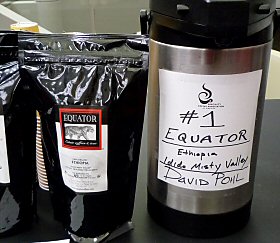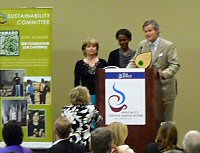Two coffee competitions took place at the Specialty Coffee Association of America expo in association with The Roasters Guild: the Roaster’s Choice Tasting Award and the Coffee of the Year.
The ten Roaster’s Choice coffees were available for tasting during the expo and everybody was able to cast a vote for their favorite. We had a lot of fun with this last year. The competition was held in a more convenient location then, so we were able to go back more frequently to taste the coffees. Still, it was worthwhile to taste so many flavors in an array of coffees.
The results were interesting: half the winners Ethiopian, including the top three — two of which were from the same cooperative. Last year the number one coffee was an Ethiopian. The winners are below; I have more info on the top three because they were displayed at the expo. The rest are from a release from the SCAA that only lists the roaster and country of origin (see my comments at the end of the post). Update: I’ve added additional information received in the comments.
 1. Equator Estate Coffee & Teas — Ethiopia Idido Misty Valley — roasted by David Pohl.
1. Equator Estate Coffee & Teas — Ethiopia Idido Misty Valley — roasted by David Pohl.
2. Caffe Pronto — Ethiopia Wondo Worka, Yirgacheffe — roasted by Andy Sprenger (Andy also came in 2nd out of 22 in the first U.S. Cup Tasters Competition, where folks compete to identify coffees in the shortest time in triangulation rounds). This coffee also received a 92 from Coffee Review. Talk about potently floral — wow.
3. Berres Brothers Coffee — Ethiopia Wondo Worka, Yirgacheffe — roasted by John Johnson. This was the only one of the top three that also made my top three. Also distinctly floral, but I like my Ethiopian’s a little more subtle.
4. Flying Goat Coffee — Costa Rica, Cafetin de San Martin micro mill, Terrazu, 2009 crop.
5. Barefoot Coffee Roasters — Ethiopi, Oromiya, Yirgacheffe, Dominion Trading Co. Certified organic. Reviewed at Coffee Review.
6. Tony’s Coffee and Teas — Sulawesi Toraja Peaberry Toarco.
7. Intelligentsia — Ethiopia Yirgacheffe, I presume their Direct Trade Kurimi.
8. Kaldi’s Coffee Roasting — Burundi Kinyovu.
9. Coffeesnobs.com.au — Bolivia Flor de Cafe San Ignacio.
10. Aroma Trading Co. — R&A Javar farms, milled by Pavaraga, Hawaii — roasted by Dan Tang. Exclusive rights on U.S. mainland to Kean Coffee.
Single origin coffees in the Coffee of the Year competition were evaluated by industry cupping professionals in several rounds over the weekend. There were 135 coffees entered. Here are the top ten, with the silly misspellings from the official SCAA press release corrected:
1. Colombia — C.I. Virmax Colombia S.A, Los Naranjos, San Agustin, Huila (88.66).
2. Panama — Hacienda La Esmeralda, Boquete (87.69). After winning first place in 2005-2007, this also came in second to a Colombian last year.
3. Ethiopia — Ninety Plus Coffee, Aricha Micro Selection 14, Yirgacheffe (87.03)
4. Colombia — C.I. Racafe & CIA S.C.A., Santa Maria, Huila (85.78). Racafe came in first place last year.
5. Kenya — Royal Coffee, NY, Gethumbwini Estate, Aberdare Ranges (85.72)
6. Guatemala — El Injerto, S.A., La Libertad, Huehuetenango (85.59). Rainforest Alliance certified; shade is rather low on native diversity, but there is forest reserve on the property as well.
7. Hawaii — Kailiawa Coffee Farm (sponsored by Ka’u Farm and Ranch Company LLC, milled by Pavaraga), District of Ka’u on the Big Island if Hawaii (85.05)
8. Colombia — C.I. Virmax Colombia S.A., La Piramide (Inza, Cauca) (85.00)
9. El Salvador — Exportadora El Volcan S.A. de C.V., Finca Shangrila, Apaneca/Ilamatepec Mountain Range (84.89)
10. Guatemala — San Diego Buena Vista, Acatenango (84.86). Rainforest Alliance certified, came in third out of the Guatemalan coffees in the Rainforest Alliance Cupping for Quality awards, where it scored 83.75.
Sorry, but I’m disappointed in the Roasters Guild and SCAA for the way they publicized the results of these competitions. It took a week for me to dig up the list of winners for the Roasters Choice awards; they didn’t even send a press released to registered media. As I noted, just a list of the roaster and country of origin. There were no other details on the coffee, nor did they give the numbers they were assigned in the blind tasting, so I can’t even tell you which one I liked the best. The press release for the Coffee of the Year was more prompt, but had several misspellings, which I corrected above. Really, it’s embarrassing for the SCAA not to correctly spell “Yirgacheffe.”










